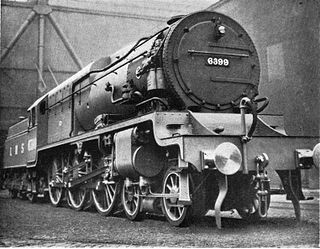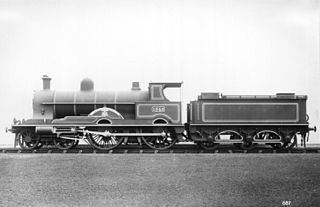| LMS Rebuilt Jubilee Class | |||||||||||||||||||||||||||||||||||||||||||||||||
|---|---|---|---|---|---|---|---|---|---|---|---|---|---|---|---|---|---|---|---|---|---|---|---|---|---|---|---|---|---|---|---|---|---|---|---|---|---|---|---|---|---|---|---|---|---|---|---|---|---|
 45735 Comet at Wigan (North Western) in June 1957 | |||||||||||||||||||||||||||||||||||||||||||||||||
| |||||||||||||||||||||||||||||||||||||||||||||||||
| |||||||||||||||||||||||||||||||||||||||||||||||||
| |||||||||||||||||||||||||||||||||||||||||||||||||
| |||||||||||||||||||||||||||||||||||||||||||||||||
The London, Midland and Scottish Railway (LMS) Rebuilt Jubilee Class consisted of two 4-6-0 steam locomotives.
| LMS Rebuilt Jubilee Class | |||||||||||||||||||||||||||||||||||||||||||||||||
|---|---|---|---|---|---|---|---|---|---|---|---|---|---|---|---|---|---|---|---|---|---|---|---|---|---|---|---|---|---|---|---|---|---|---|---|---|---|---|---|---|---|---|---|---|---|---|---|---|---|
 45735 Comet at Wigan (North Western) in June 1957 | |||||||||||||||||||||||||||||||||||||||||||||||||
| |||||||||||||||||||||||||||||||||||||||||||||||||
| |||||||||||||||||||||||||||||||||||||||||||||||||
| |||||||||||||||||||||||||||||||||||||||||||||||||
| |||||||||||||||||||||||||||||||||||||||||||||||||
The London, Midland and Scottish Railway (LMS) Rebuilt Jubilee Class consisted of two 4-6-0 steam locomotives.
Both were rebuilt in 1942 from the LMS Jubilee Class engines—5736 Phoenix in April 1942 and 5735 Comet a month later. They were the second and third examples of the 2A-boilered locomotives, following on from the 1935 pioneer rebuild 6170 British Legion. Both Jubilees had been built in 1936 at Crewe Works, and therefore their original type 3A boilers were not life expired and hence were refurbished and reused on different engines rather than being scrapped. They were given the power classification 6P.
From 1943, it was decided not to repeat the conversion on the remaining 189 members of the Jubilee Class. Rather it was decided to rebuild members of the LMS Royal Scot Class into the LMS Rebuilt Royal Scot Class.
Both were inherited by British Railways in 1948, and had 40000 added to their numbers so that they became 45735/6. 45736 Phoenix was withdrawn in September 1964 and 45735 Comet followed in October. Neither was preserved.

The London, Midland and Scottish Railway (LMS) Princess Royal Class is a class of express passenger 4-6-2 steam locomotive designed by William Stanier. Twelve examples were built at Crewe Works, between 1933 and 1935, for use on the West Coast Main Line. Two are preserved.
The London, Midland and Scottish Railway had the largest stock of steam locomotives of any of the 'Big Four' Grouping, i.e. pre-Nationalisation railway companies in the UK. Despite early troubles arising from factions within the new company, the LMS went on to build some very successful designs; many lasted until the end of steam traction on British Railways in 1968. For an explanation of numbering and classification, see British Rail locomotive and multiple unit numbering and classification.

The London, Midland and Scottish Railway (LMS) Jubilee Class is a class of steam locomotive designed for main line passenger work. 191 locomotives were built between 1934 and 1936. They were built concurrently with the similar looking LMS Stanier Class 5 4-6-0. They were nicknamed Red Staniers and Jubs.

The London, Midland and Scottish Railway (LMS) Stanier Class 5 4-6-0, commonly known as the Black Five, is a class of 4-6-0 steam locomotives. It was introduced by William Stanier and built between 1934 and 1951, of which 842 were built and were numbered 4658-5499. Several members of the class survived to the last day of steam on British Railways in 1968, and eighteen are preserved.

The London, Midland and Scottish Railway (LMS) Royal Scot Class is a class of 4-6-0 express passenger locomotive introduced in 1927. Originally having parallel boilers, all members were later rebuilt with tapered type 2A boilers, and were in effect two classes.

The Patriot Class was a class of 52 express passenger steam locomotives built for the London Midland and Scottish Railway. The first locomotive of the class was built in 1930 and the last in 1934. The class was based on the chassis of the Royal Scot combined with the boiler from Large Claughtons earning them the nickname Baby Scots. A total of 18 were rebuilt to create the LMS Rebuilt Patriot Class between 1946 and 1948; thereafter those not subjected to rebuilding were often referred to as the Unrebuilt Patriot Class. These remaining 34 unrebuilt engines were withdrawn between 1960 and 1962.

The London, Midland and Scottish Railway (LMS) Hughes Crab or Horwich Mogul is a class of mixed-traffic 2-6-0 steam locomotive built between 1926 and 1932. They are noted for their appearance with large steeply-angled cylinders to accommodate a restricted loading gauge.

The London, Midland and Scottish Railway (LMS) No. 6399 Fury was an unsuccessful British experimental express passenger locomotive. The intention was to save fuel by using high-pressure steam, which is thermodynamically more efficient than low-pressure steam.
Edward Thompson was an English railway engineer, and was Chief Mechanical Engineer of the London and North Eastern Railway between 1941 and 1946. Edward Thompson was born at Marlborough, Wiltshire on 25 June 1881. He was the son of Francis Thompson, assistant master at Marlborough College. He was educated at Marlborough before taking the Mechanical Science Tripos at Pembroke College, Cambridge, earning a third class degree. Thompson entered the railway scene after education, contrasting that of his predecessor Nigel Gresley, who had also attended Marlborough after gaining practical experience as a pupil at Horwich Works.

LMS Royal Scot Class 6115 Scots Guardsman is a preserved British steam locomotive. Built by the London, Midland and Scottish Railway (LMS) as a member of the Royal Scot Class, it was later operated by British Railways.

London, Midland and Scottish Railway (LMS) Royal Scot Class 6100Royal Scot is a preserved British steam locomotive.

The London, Midland and Scottish Railway (LMS) 6170British Legion was a British steam locomotive. It was the prototype for, and is sometimes considered a member of, the Rebuilt Royal Scot Class but differed from those later rebuilds principally in having a unique type 2 boiler, rather than a type 2A boiler, the two not being interchangeable.

London, Midland and Scottish Railway (LMS) Jubilee Class No. 5699Galatea is a preserved British steam locomotive.
The Midland Railway Johnson 0-6-0 were a class of locomotives serving Britain's Midland Railway system in the late 19th and early 20th centuries. Between 1875 and 1908 the Midland Railway, under the control of locomotive superintendents Samuel Waite Johnson and Richard Deeley, ordered 935 goods tender engines of 0-6-0 type, both from the railway's own shops at Derby and various external suppliers. Although there were many variations between different batches both as delivered and as successively rebuilt, all 935 can be regarded as a single series, one of the largest classes of engine on Britain's railways. The locomotives served as late as 1964, but none of them now survive.

The London Midland and Scottish Railway (LMS), Rebuilt Patriot Class was a class of 4-6-0 steam locomotives. They were rebuilt from LMS Patriot Class locomotives over the period 1946–1949. By the end of 1947, the LMS had rebuilt seven engines, these being 5514/21/26/29–31/40. After nationalisation, a further eleven locomotives were rebuilt. Rebuilt locomotives retained their numbers.

The London, Midland and Scottish Railway (LMS) Rebuilt Royal Scot Class is a class of 4-6-0 steam locomotives. 70 members of this class were rebuilt by the LMS and its successor British Railways (BR) from LMS Royal Scot Class engines by the replacement of their life expired parallel boilers with a type 2A boiler over the period 1943–1955.. They were the second class to be rebuilt with type-2 boilers, after the rebuilding of British Legion and the Jubilee Class.

The London and North Western Railway (LNWR) Alfred the Great class, after modification known as the Benbow Class was a class of 4-4-0 4-cylinder compound locomotives by F.W. Webb. A total of forty were built from 1901–1903. They were a development of the Jubilee Class, with a slightly larger boiler.
The London, Midland and Scottish Railway (LMS) 2 and 2A boilered 4-6-0 locomotives were express passenger 4-6-0 steam locomotives. In 1935, William Stanier, Chief Mechanical Engineer of the LMS, ordered the rebuilding of the unique experimental high pressure compound locomotive 6399 Fury. The Schmidt-Henschel boiler was replaced with a tapered boiler, with a drumhead smokebox, designated type 2. The type 2 boiler had a tube surface of 1,669 square feet, formed by tubes 2⅛ inches in diameter and 14 feet 3 inches long. It was fitted with a 28 row superheater with 360 square feet of heating surface. The superheater elements, 1⅛ inch in diameter, were fitted into flue tubes 5⅛ inches diameter.

No.5551 The Unknown Warrior is a replica LMS Patriot Class steam locomotive which is under construction in the Midland Railway – Butterley's West Shed.

A double chimney is a form of chimney for a steam locomotive, where the conventional single opening is duplicated, together with the blastpipe beneath it. Although the internal openings form two circles, the outside appearance usually forms a single elongated oval.